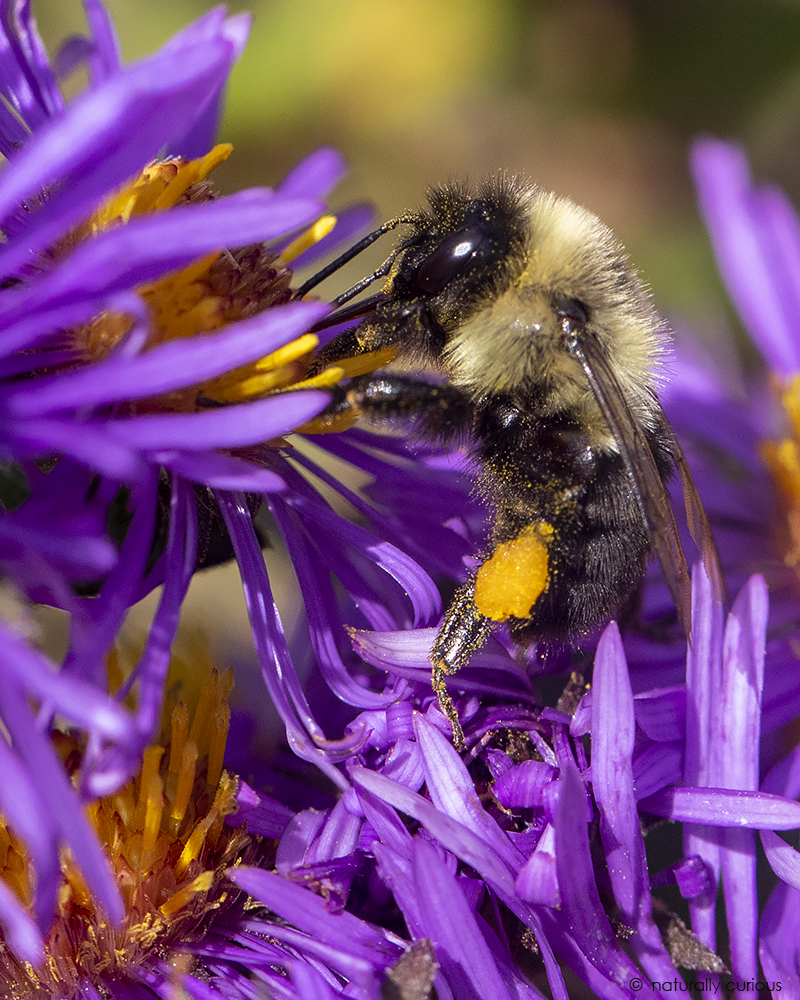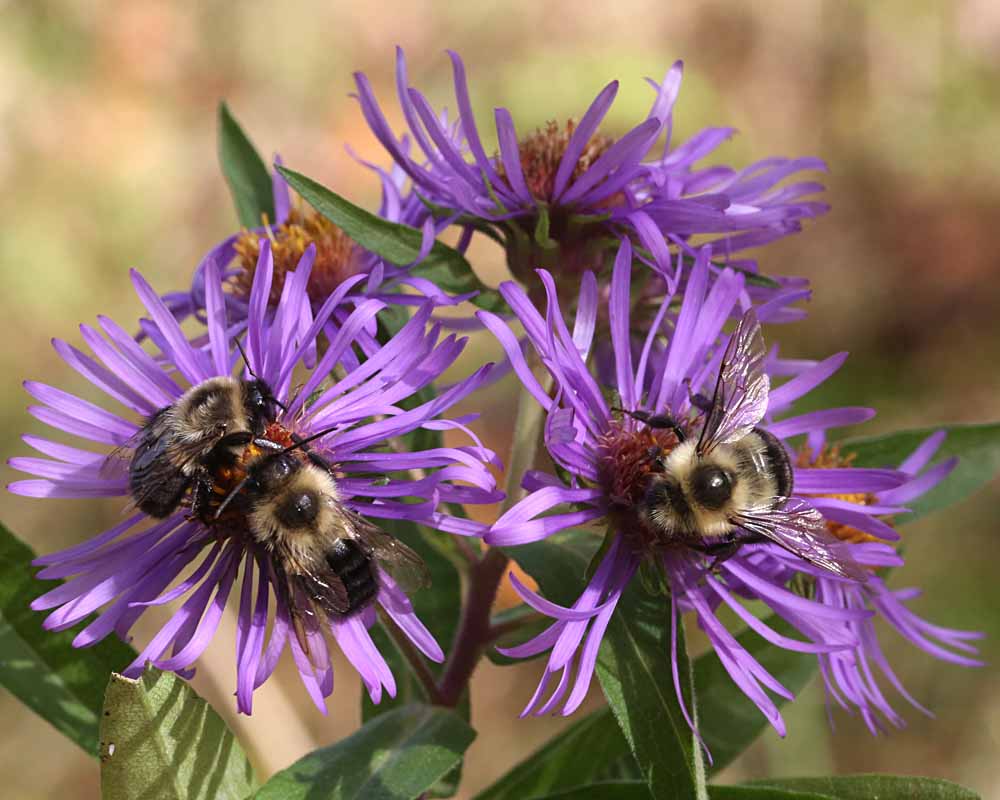Newly-hatched Bumble Bees Resting At Night Before Foraging & Mating During The Day

At this time of year bumble bee larvae develop into virgin queens and males instead of the female workers that hatch during the summer. Chances are if you take an early morning walk when fall temperatures are starting to drop, you may come across one of the male bumble bees in an immobile state resting on a goldenrod or aster flower. Having spent the night here due to cold temperatures (their flight muscles must be above 86°F in order for them to take flight and their thorax must be maintained during flight at 86-104°F), they use their wing muscles in the morning to shiver and raise their temperature until they are capable of flight.
Young queens are visible during the day, but return to the hive for shelter during the night. Once they have mated and are fertilized they fill their honey sacs with honey and seek shelter for the winter several inches underground. They are the only members of the hive to overwinter; all others perish in the fall. (Photo: male bumble bee resting on New England Aster early one fall morning.)
Naturally Curious is supported by donations. If you choose to contribute, you may go to http://www.naturallycuriouswithmaryholland.wordpress.com and click on the yellow “donate” button.
Pollen Baskets

Due to their tolerance of cold temperatures, bumblebees can still be found foraging on late-blooming flowers such as New England Asters (Symphyotrichum novae-angliae). Most worker bees collect and carry pollen in a dense mass of elongated and often branched hairs (setae) on their hind legs called a scopa. Honeybees and bumblebees, however, have pollen baskets, or corbiculae, in which they place and carry pollen back to their hive. Pollen baskets consist of a polished cavity located on the tibia of each of their hind legs which is surrounded by a fringe of hairs. Pollen is pressed on to the pollen basket when it has been collected by the combs and brushes on the inside of the bee’s legs. The bumblebee moistens the pollen with some nectar to make it sticky and stay in the basket. The pollen is loaded at the bottom of the pollen basket, so the pollen that has been pushed towards the top is from flowers the bumblebee visited earliest on her foraging trip. When a pollen basket is full it can weigh as much as 0.01 gram and contain as much as 1,000,000 pollen grains.
Only queen bumblebees overwinter, and they must start a new colony in the spring. When the queen first emerges you can tell whether or not she has started a nest by looking at her pollen baskets. If she is carrying pollen then she has found a nest site.
Naturally Curious is supported by donations. If you choose to contribute, you may go to http://www.naturallycuriouswithmaryholland.wordpress.com and click on the yellow “donate” button.
A Butterfly’s Proboscis May Act More Like A Paper Towel Than A Straw
 The chewing mouthparts of a butterfly larva, or caterpillar, undergo changes when the larva develops into an adult butterfly. They are turned into a tube consisting of two parts, or galeae, that when joined form a structure called a proboscis. The proboscis looks like a straw, and has long been thought to act like one. It is often referred to as a sipping tool through which nectar is obtained by butterflies. However, recent discoveries have scientists thinking that the proboscis works more like a paper towel than a straw.
The chewing mouthparts of a butterfly larva, or caterpillar, undergo changes when the larva develops into an adult butterfly. They are turned into a tube consisting of two parts, or galeae, that when joined form a structure called a proboscis. The proboscis looks like a straw, and has long been thought to act like one. It is often referred to as a sipping tool through which nectar is obtained by butterflies. However, recent discoveries have scientists thinking that the proboscis works more like a paper towel than a straw.
The liquid that a butterfly feeds on in addition to nectar – animal tears, juice inside decomposed fruit, tree sap, sweat, liquid contained in scat – is so viscous that sipping or pumping it through the proboscis, or feeding tube, would require an enormous amount of pressure. It’s been suggested by entomologist Konstantin Kornev of Clemson University that butterflies draw liquid upwards using capillary action – the same force that pulls liquid into a paper towel. The proboscis actually resembles a rolled-up paper towel, with tiny grooves that pull the liquid upwards along the edges, carrying along the bead of liquid in the middle of the tube. (Photo: Sulphur Butterfly on New England Aster)
Naturally Curious is supported by donations. If you choose to contribute, you may go to https://naturallycuriouswithmaryholland.wordpress.com and click on the yellow “donate” button.
New England Aster Providing Bees with Late Season Nectar & Pollen
 At a time of year when nectar and pollen sources are few and far between, New England Aster provides many species of bees with food. This composite seems designed specifically for easy pollination. Its open, wide flower shape provides a flat surface for insects to land on, and because the nectar and pollen are not hidden deep inside the flowers, both long- and short-tongue bee species can easily access them. Unlike honeybees, bumblebees do not have a large store of honey in their nests, so they need pollen and nectar throughout the season. Thus, the few flowers such as New England Aster that blossom as late as October are visited frequently and in large numbers. (Only the queen bumblebee overwinters, but the workers continue collecting nectar and pollen up until they die in late fall.)
At a time of year when nectar and pollen sources are few and far between, New England Aster provides many species of bees with food. This composite seems designed specifically for easy pollination. Its open, wide flower shape provides a flat surface for insects to land on, and because the nectar and pollen are not hidden deep inside the flowers, both long- and short-tongue bee species can easily access them. Unlike honeybees, bumblebees do not have a large store of honey in their nests, so they need pollen and nectar throughout the season. Thus, the few flowers such as New England Aster that blossom as late as October are visited frequently and in large numbers. (Only the queen bumblebee overwinters, but the workers continue collecting nectar and pollen up until they die in late fall.)
New England Aster flowers close at night, when there are fewer pollinating insects flying. If an unusually cool period arrives during the time when New England Aster is blooming, the blossoms also close. Although it may seem that the aster is losing pollination opportunities during a cold day, bees are not very active in cool weather.
Naturally Curious is supported by donations. If you choose to contribute, you may go to http://www.naturallycuriouswithmaryholland.wordpress.com and click on the yellow “donate” button.


















What Other Naturally Curious People Are Saying